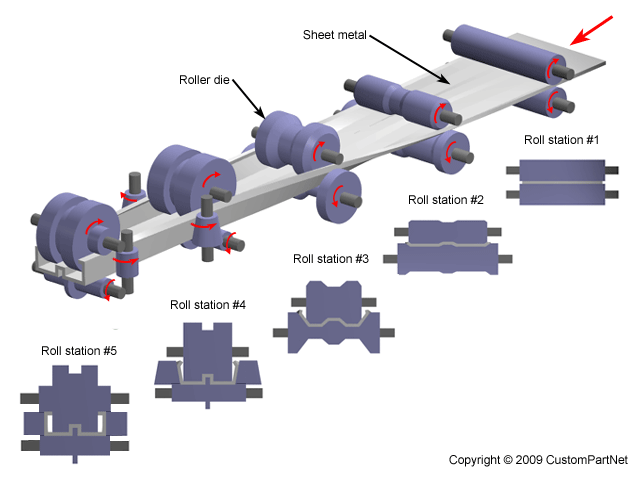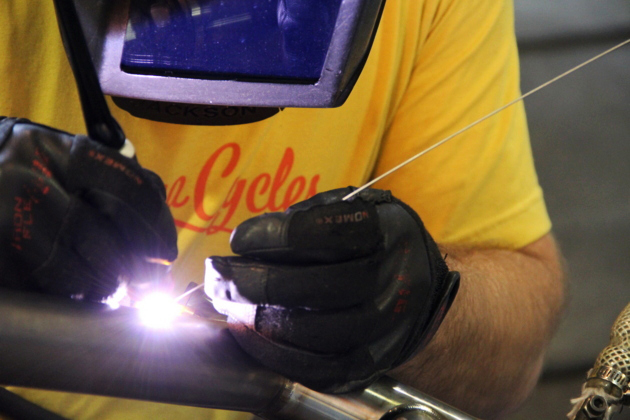What is Brazing ?
Brazing is a metal-joining process whereby a filler metal is heated above and distributed between two or more close-fitting parts by capillary action. The filler metal is brought slightly above its melting (liquidus) temperature while protected by a suitable atmosphere, usually a flux. It then flows over the base metal (known as wetting) and is then cooled to join the workpieces together. It is similar to soldering, except the temperatures used to melt the filler metal are above 450 °C (842 °F).
Brazing
Brazing, simply put, is joining metal to metal by filling the joint with a different, melted metal at temperatures over 840F. If the process is hot enough to melt the metals being joined, it becomes welding or braze-welding.The pieces being joined together are referred to as the base metal, while the melted metal that fills the gap between them is called the filler metal. Filler metal is also called brazing rod, spelter, or brazing alloy. The following discussion of brazing focuses on the techniques and materials used in brazing bicycle frames, but most of the information applies to any similar brazing of light-weight steel components.
As the name implies, brazing is usually done with a filler made of some form of brass or bronze, alloys of copper with zinc, tin, and other metals. Brass and bronze brazing alloys typically melt at temperatures over 1500F, sometimes as high as 2000F. For tubing that has not been heat treated, such as Reynolds 531 or plain 4130 chromoly steel, brass brazing is entirely appropriate. It produces joints that are more than strong enough for a bicycle frame, it costs much less than silver, and it is a more forgiving process, allowing wider tolerances in tube metering and temperature control.
The vast majority of brazed production bicycle frames, and a large share of custom frames, are all brass or bronze brazed. In order to obtain high-quality brazed joints, parts must be closely fitted, and the base metals must be exceptionally clean and free of oxides. In most cases, joint clearances of 0.03 to 0.08 mm (0.0012 to 0.0031 in) are recommended for the best capillary action and joint strength.
However, in some brazing operations it is not uncommon to have joint clearances around 0.6 mm (0.024 in). Cleanliness of the brazing surfaces is also of vital importance, as any contamination can cause poor wetting (flow). The two main methods for cleaning parts, prior to brazing are chemical cleaning, and abrasive or mechanical cleaning. In the case of mechanical cleaning, it is of vital importance to maintain the proper surface roughness as wetting on a rough surface occurs much more readily than on a smooth surface of the same geometry.
Brazing the Copper
Another consideration that cannot be over-looked is the effect of temperature and time on the quality of brazed joints. As the temperature of the braze alloy is increased, the alloying and wetting action of the filler metal increases as well. In general, the brazing temperature selected must be above the melting point of the filler metal. However, there are several factors that influence the joint designer’s temperature selection.
The best temperature is usually selected so as to : (1) be the lowest possible braze temperature, (2) minimize any heat effects on the assembly, (3) keep filler metal/base metal interactions to a minimum, and (4) maximize the life of any fixtures or jigs used. The effect of time on the brazed joint primarily affects the extent to which the aforementioned effects are present; however, in general most production processes are selected to minimize brazing time and the associated costs. Typically, custom bicycle frames are brazed by hand. The frame pieces are held in place with a jig, and the builder heats the joints one at a time with a hand held oxy-acetylene torch.
A variety of alloys are used as filler metals for brazing depending on the intended use or application method. In general, braze alloys are made up of 3 or more metals to form an alloy with the desired properties. The filler metal for a particular application is chosen based on its ability to: wet the base metals, withstand the service conditions required, and melt at a lower temperature than the base metals or at a very specific temperature.
Brazing is a metal-joining process whereby a filler metal is heated above and distributed between two or more close-fitting parts by capillary action
Braze alloy is generally available as rod, ribbon, powder, paste, cream, wire and preforms (such as stamped washers). Depending on the application, the filler material can be pre-placed at the desired location or applied during the heating cycle. For manual brazing, wire and rod forms are generally used as they are the easiest to apply while heating. In the case of furnace brazing, alloy is usually placed beforehand since the process is usually highly automated.
Some of the more common types of filler metals used are :
- Aluminum-silicon
- Copper
- Copper-phosphorus
- Copper-zinc (brass)
- Gold-silver
- Nickel alloy
- Silver
Amorphous brazing foil using nickel, iron, copper, silicon, boron, phosphorus, etc.
In the past, many bicycles were brazed over an open hearth, rather than with a torch. In the case of brazing operations not contained within an inert or reducing atmosphere environment (i.e. a furnace), flux is required to prevent oxides from forming while the metal is heated. The flux also serves the purpose of cleaning any contamination left on the brazing surfaces. Flux can be applied in any number of forms including flux paste, liquid, powder or pre-made brazing pastes that combine flux with filler metal powder.
Flux can also be applied using brazing rods with a coating of flux, or a flux core. In either case, the flux flows into the joint when applied to the heated joint and is displaced by the molten filler metal entering the joint. Excess flux should be removed when the cycle is completed because flux left in the joint can lead to corrosion, impede joint inspection, and prevent further surface finishing operations.
Phosphorus-containing brazing alloys can be self-fluxing when joining copper to copper. Fluxes are generally selected based on their performance on particular base metals. To be effective, the flux must be chemically compatible with both the base metal and the filler metal being used. Self-fluxing phosphorus filler alloys produce brittle phosphides if used on iron or nickel. As a general rule, longer brazing cycles should use less active fluxes than short brazing operations.
You might also like
| Welding What is Welding ? Welding is a fabrication... | Metal Forming Processes Forming Processes of Metal Metal deformations... | Induction Heating What is Induction Heating ? Induction heating... | How to weld Titanium ? Welding Titanium Titanium and most titanium... |



 Alloy Suppliers
Alloy Suppliers
 Aluminum
Aluminum
 Aluminum Extrusions
Aluminum Extrusions
 Copper-Brass-Bronze
Copper-Brass-Bronze
 Nickel
Nickel
 Magnets
Magnets
 Stainless Steel
Stainless Steel
 Stainless Steel Tubing
Stainless Steel Tubing
 Steel Service Centers
Steel Service Centers
 Titanium
Titanium
 Tungsten
Tungsten
 Wire Rope
Wire Rope